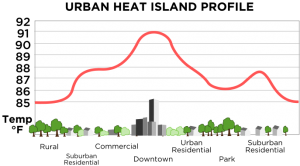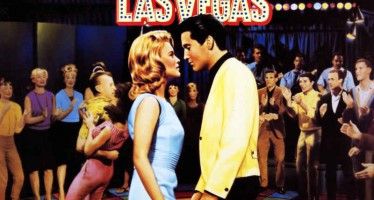Cap and trade shifts from cutting smog to shifting wealth
By Wayne Lusvardi
California is subtly shifting the spending goals of its cap-and-trade taxes from reducing air pollution to reducing the “urban heat island effect.” In so doing, it believes it has found a green justification finally to divert pollution taxes to pet political low-income constituencies of the majority Democratic Party.
In 2012, the California legislature passed a law to divert cap-and-trade taxes to low-income communities under Senate Bill 535. But that legislation needed a scientific justification for diverting taxes these communities, many of which have less air pollution than wealthier but smog-prone suburban communities.
Now, Gov. Jerry Brown’s Office of Planning and Research has found what it believes will be a scientific justification for redistributing cap-and-trade taxes from the suburbs to low-income communities: reducing the urban heat island effect.
The urban heat island effect is defined as a “higher-temperature ‘dome’ of heat created over an urban or industrial area by hot layers forming at building top or chimney level.” The “heat island effect” disappears by midday, when temperatures rise, so it technically should be called the “nighttime urban heat island effect.” The science behind reducing urban heat island effects has been seriously questioned by scientists from California’s highest institutions of learning.
Green smokescreens for wealth redistribution
Anthony Watts reports on his website WattsUpWithThat.com that the motivation for this project is to provide justification for CalEnviroScreen. This is a so-called scientific-based method for lessening environmental impacts on disadvantaged communities. In other words, neighborhoods near freeways or smokestack industries might end up with utility bill subsidies or green jobs projects to offset “global warming” by reducing urban hot spots.
Ironically, the alleged low-income victims of urban heat islands are the same people who travel on hot concrete surface freeways. How are wealthier suburbs any less affected by the urban heat island effects from freeways than industrial areas?
The shift from reducing air pollution to reducing urban hot spots is politically necessary because California government has to concoct some green justification for failing to clean up suburban smog. Air pollution doesn’t stay put in the Los Angeles Air Basin or anywhere else. In Los Angeles County, any visible pollution is typically pushed up into the wealthy suburbs near the San Gabriel Mountains, such as Pasadena, Arcadia, Fontana, Rancho Cucamonga and Upland.
Should smoggy and wealthy industrial-based cities — such as the City of Industry, the City of Commerce, and Vernon in Southern California — subsidize “poorer” but clean coastal cities such as Oxnard, National City, and the Wilmington area of Los Angeles? Where is the science behind such a policy?
Should smoggy inland agricultural cities in the Central Valley — such as Visalia-Porterville, Fresno, Merced and Bakersfield — end up subsidizing green jobs in lower-income industrialized coastal industrial cities that have cleaner coastal air, such as Oakland, Alameda and Richmond?
The governor’s apparent solution to this dilemma is to subtly shift from the air pollution reduction goals of cap and trade to reducing the effects of urban heat islands. Presumably, the suburbs are greener and thus cooler than the central cities and industrial areas. So cap-and-trade taxes would be diverted from reducing suburban air pollution to reducing urban hot spots in low-income communities, many of which ironically have cleaner air.
Carbon offsets for reducing urban heat islands
This is why California’s Cap and Trade program is considering 25 projects that would, for the first time, allow carbon offset credits. Among the projects being considered are timber harvesting and the reduction of bio-gas from farm animals. The reduction of urban heat islands will likely be added to the list of eligible carbon offset projects.
There is little political compromise between suburbs and cities in this scheme to shift from pollution reduction to reduction in wealth inequality. Wealthy suburbs won’t get any smog reduction or higher property values in return for being disproportionately taxed to create green jobs programs or utility bill subsidies in lower-income areas.
Opinion polls shows that lower-income communities do not perceive environmental issues as a high cause of concern. The intent of this shift is to buy green votes in blue collar communities at the expense of white collar suburbs that won’t get any real reduction in air pollution specifically from this action.
How the smokescreen of science behind the state’s CalEnviroScreen computer model can withstand legal challenge also is questionable. There is no legal nexus — logical connection — between air pollution emissions and urban heat-island effects. And many lower-income areas arguably have cleaner air than wealthier suburbs.
Making communities cooler would also likely result in worsening the “inversion layer” that traps smog. The state’s shift from reducing air pollution to reducing urban heat island effects might also end up reducing the credibility of science and, if voters revolt, the Democratic Party supermajorities in the state Legislature that concoct such programs.
Related Articles
Sen. Lieu And The River Called Denial
Commentary MAY 19, 2011 By STEVEN GREENHUT California’s fiscal problems are only front-page national news thanks to the state’s structural
Broke State Budget Hits Dead End
FEB. 29, 2012 By KATY GRIMES In in an effort to avoid a cash-flow problem, State Treasurer Bill Lockyer appeared




